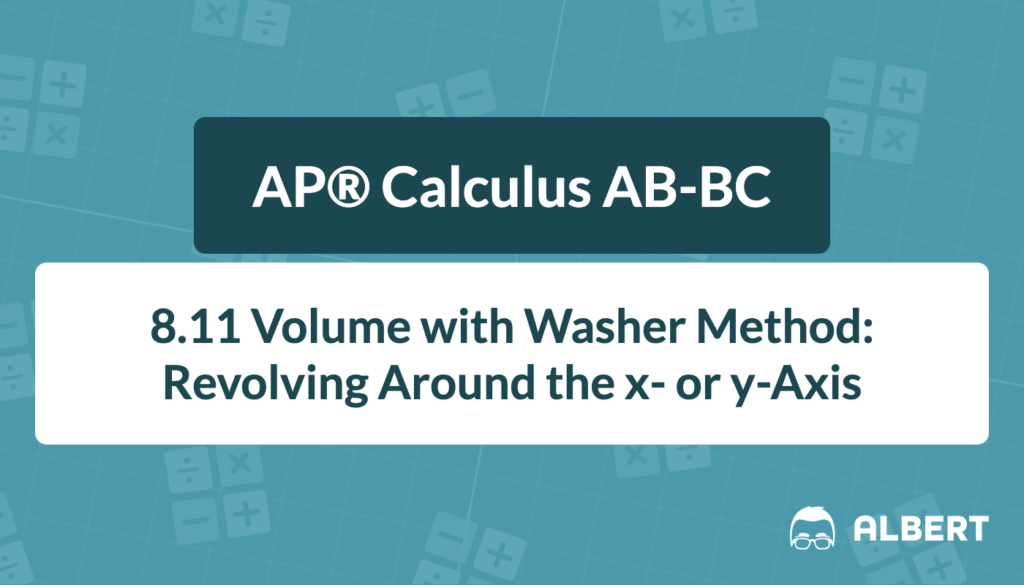Volumes of revolution appear in several AP® Calculus FRQs. Because of this, understanding the disc and washer method family is vital for exam success. Today’s spotlight falls on the washer method formula, the tool used whenever the solid has a hollow “tube” running through it.
What We Review
Big Picture: Disc vs. Washer
When a Disc Works
A disc is perfect when every cross-section, perpendicular to the axis of rotation, is a solid circle. In that case, the radius runs from the axis straight to the boundary curve.
Why a Washer Is Needed
However, many regions leave a gap after revolving. Therefore, each slice looks like a flat doughnut—a washer. Because of the hole, two radii matter:
- Outer radius R
- Inner radius r
Visual Analogy: “Stacking Bagels vs. Stacking Cookies”
Imagine stacking cookies. No hole appears, so the pile is solid—like the disc method. Meanwhile, stacking bagels leaves a tunnel through the middle, matching the washer picture.
The Washer Method Formula Unpacked
Revolving About the x-Axis
V = \pi \int_{a}^{b} \bigl(R(x)^2 - r(x)^2\bigr)dxRevolving About the y-Axis
V = \pi \int_{c}^{d} \bigl(R(y)^2 - r(y)^2\bigr)dyIdentify each symbol:
- V – volume
- \pi – constant from circle area
- a, b, c, d – limits of integration
- R – outer radius (curve farthest from the axis)
- r – inner radius (curve closest to the axis)
Tip: When choosing radii, always sketch first. The curve that sits farther from the axis after rotation supplies R; the nearer curve supplies r.
Step-by-Step Road Map
- Sketch the region and mark the axis of rotation.
- Next, label the outer and inner radii on the sketch.
- Then, set the limits of integration from the graph’s intercepts.
- Write the washer method formula with the correct variable.
- Finally, integrate and evaluate.
Example 1: Revolving Around the x-Axis
Region: between y=\sqrt{x}, the x-axis, and x=0 to x=4. Rotate about the x-axis.
Solution
Because rotation is about the x-axis, each slice is horizontal:
- Outer radius: from axis to upper curve R(x)=\sqrt{x}
- Inner radius: axis to x-axis is 0, so r(x)=0
Therefore,
\begin{aligned}V = \pi\int_{0}^{4} \bigl((\sqrt{x})^2 - 0^2\bigr)dx = \pi\int_{0}^{4} x dx = \pi\left[\tfrac{1}{2}x^{2}\right]_{0}^{4} = \pi\left(\tfrac{1}{2}\cdot16\right) = 8\pi\end{aligned}Hence, the volume equals 8\pi cubic units.
Example 2: Revolving Around the y-Axis
Region: between x=y^{2} and x=2y from y=0 to y=2. Rotate about the y-axis.
Solution
Because rotation is about the y-axis, use vertical slices. First, decide radii in terms of y.
- Outer radius: distance from axis (x=0) to the right-most curve x=2yR(y) = 2y
- Inner radius: distance from axis to left curve x=y^{2}\rightarrow r(y) = y^{2}
Therefore,
\begin{aligned}V = \pi\int_{0}^{2} \bigl( (2y)^2 - (y^{2})^2 \bigr)dy = \pi\int_{0}^{2} \bigl(4y^{2} - y^{4}\bigr)dy = \pi\left[\tfrac{4}{3}y^{3} - \tfrac{1}{5}y^{5}\right]_{0}^{2} = \pi\left(\tfrac{4}{3}\cdot8 - \tfrac{1}{5}\cdot32\right) = \pi\left(\tfrac{32}{3} - \tfrac{32}{5}\right) = \pi\left(\tfrac{160 - 96}{15}\right) = \tfrac{64\pi}{15}\end{aligned}Thus, the volume equals \dfrac{64\pi}{15} cubic units.
Graphing Tips and Common Pitfalls
- Always draw both curves. However, double-check which one is farther; otherwise, R and r may swap.
- Remember to square both radii before subtracting. Therefore, leave no negative area inside the integral.
- Units count. Consequently, if the problem uses inches, the volume arrives in cubic inches.
- Finally, confirm the axis of rotation. A misread axis changes everything.
Quick Reference Chart: Key Vocabulary
| Term | Meaning |
| Washer | A flat ring-shaped slice (doughnut) |
| Disc | A solid circular slice |
| Outer radius R | Distance from axis to far curve |
| Inner radius r | Distance from axis to near curve |
| Axis of rotation | Line the region spins around |
| Limits of integration | Start and end values for x or y |
| Washer method formula | V=\pi\int (R^2-r^2)dx\text{ or }dy |
Conclusion
The washer method formula appears in College Board standard CHA-5.C.3. Because this topic blends geometry with integrals, students should always combine clear sketches with algebraic work. Therefore, consistent practice with both the disc and washer method builds speed and confidence for the AP® Calculus AB-BC exam.
Sharpen Your Skills for AP® Calculus AB-BC
Are you preparing for the AP® Calculus exam? We’ve got you covered! Try our review articles designed to help you confidently tackle real-world math problems. You’ll find everything you need to succeed, from quick tips to detailed strategies. Start exploring now!
- 8.10 Volume with Disc Method: Revolving Around Other Axes
- 8.12 Volume with Washer Method: Revolving Around Other Axes
Need help preparing for your AP® Calculus AB-BC exam?
Albert has hundreds of AP® Calculus AB-BC practice questions, free responses, and an AP® Calculus AB-BC practice test to try out.








